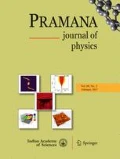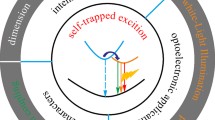Abstract
The effects of spatially dependent effective mass, non-parabolicity of the conduction band and dielectric screening function on exciton binding energy in a pyramid-shaped quantum dot of GaAs have been investigated by variational method as a function of base width of the pyramid. We have assumed that the pyramid has a square base with area \(a\times a\) and height of the pyramid \(H=a/2\). The trial wave function of the exciton has been chosen according to the even mirror boundary condition, i.e. the wave function of the exciton at the boundary could be non-zero. The results show that (i) the non-parabolicity of the conduction band affects the light hole (lh) and heavy hole (hh) excitons to be more bound than that with parabolicity of the conduction band, (ii) the dielectric screening function (DSF) affects the lh and hh excitons to be more bound than that without the DSF and (iii) the spatially dependent effective mass (SDEM) affects the lh and hh excitons to be less bound than that without the SDEM. The combined effects of DSF and SDEM on exciton binding energy have also been calculated. The results are compared with those available in the literature.








Similar content being viewed by others
References
S Mosleni-Tabrizi, Eigenstate calculations for multidimensional nanostructures: Quantum wells, wires and dot (VDM Verlag Dr. Muller Aktiengesellschaft & Co.KG, Germany, 2008)
E Kasapoglu and I Sokmen, Physica E 27, 198 (2005)
S Wu, Physica B 406, 4634 (2011)
N Elmeshad, H Abdelhamid, H Hassanein, S Abdelmota and S Said, Chin. J. Phys. 47, 92 (2009)
Z Xiao, J. Appl. Phys. 86, 4509 (1999)
A Taqi and J Diouri, Semicond. Phys. Quantum Electron. Optoelectron. 15, 365 (2012)
B Sukumar and K Navaneethakrishnan, Solid State Commun. 76, 561 (1990)
H Akbas, S Aktas, S E Okan and M Ulas, Solid State Commun. 23, 113 (1998)
Z Y Deng, J K Guo and T R Lai, Phys. Rev. B 50, 5736 (1994)
X H Qi, X J Kong and J J Liu, Phys. Rev. B 58, 10578 (1998)
A J Peter and K Navaneethakrishnan, Physica E 40, 2747 (2008)
S Nomura and T Kobayashi, Solid State Commun. 78, 677 (1991)
N Schildermans, M Hayne, V V Moshchalkov, A Rastelli and O G Schmidt, Phys. Rev. B 72, 115312 (2005)
Y Sidor, B Partoens, F M Peeters, J Maes, M Hayne, D Fuster, Y Gonzalez, L Gonzalez and V V Moshchalkov, Phys. Rev. B 76, 195320 (2007)
L C Andreani and A Pasquarello, Phys. Rev. B 42, 8928 (1990)
U Ekenberg and M Altarelli, Phys. Rev. B 35, 7585 (1987)
V Lozovski and V Piatnytsia, J. Comput. Theor. Nanosci. 8, 2335 (2011)
Y Vorobiev, V Vieira, P Ribeiro, V Gorley, P Horley, J G Hernandez and T Torchynska, Recent Researches in Communications, Automation, Signal Processing, Nanotechnology, Astronomy and Nuclear Physics, 127 (WSEAS Press, 2011)
Yu V Vorobiev, T V Torchynska and P P Horley, Physica E 51, 42 (2013)
M Grundmann, O Stier and D Bimberg, Phys. Rev. B 52, 11969 (1995)
M A Borji, A Reyahi, E Rajaei and M Ghahremani, Pramana – J. Phys., https://doi.org/10.1007/s12043-017-1424-x (2017)
K Jayakumar, S Balasubramanian and M Tomak, Phys. Rev. B 33, 4002 (1986)
M Arulmozhi and S Balasubramanian, Phys. Rev. B 51, 2592 (1995)
Acknowledgements
The authors thank the University Grants Commission (UGC), New Delhi, India, for the financial support through Major Research Project (No.F.42-836 / 2013(SR) dated 22.3.2013) and the authorities of Jayaraj Annapackiam College for Women (Autonomous), Periyakulam, Theni District, Tamil Nadu, India, for the encouragements.
Author information
Authors and Affiliations
Corresponding author
Rights and permissions
About this article
Cite this article
Anitha, A., Arulmozhi, M. Exciton binding energy in a pyramidal quantum dot. Pramana - J Phys 90, 57 (2018). https://doi.org/10.1007/s12043-018-1548-7
Received:
Revised:
Accepted:
Published:
DOI: https://doi.org/10.1007/s12043-018-1548-7
Keywords
- Pyramid quantum dot
- dielectric screening function
- spatially dependent effective mass
- exciton
- GaAs
- non-parabolicity




